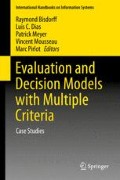Abstract
This chapter reports on a simulated decision aiding process aiming at choosing a cooling system for a new power plant. The study took place in a research contract between MathRO, the Mathematics and Operations Research unit at UMONS, and Laborelec, a technical competence centre of the Belgian power industry. The goal of the contract was to show whether and how multiple criteria decision methods could help taking the environmental and societal aspects of technical choices into account in a relevant way. In this perspective, the case of the choice of a cooling system for the Saint-Ghislain power plant was conceived as a validation exercise.
Access this chapter
Tax calculation will be finalised at checkout
Purchases are for personal use only
Notes
- 1.
That is, a cost level above which a unit cost difference has not the same value as a unit cost difference below this level.
- 2.
Note that the scale origin can be translated without any impact on the ranking obtained via a weighted sum or an additive value function. Here we could equivalently say that A 7 receives mark 2 (“very unsatisfactory” level) and A 1 receives 5. 45. Or else that A 1 receives 8 (“very satisfactory” level) and A 7 receives \(8 - 3.45 = 4.55\). Or even that A 1 receives 10 (“ideal” value) and A 7 receives \(10 - 3.45 = 6.55\). Only differences matter to the ranking in such models.
- 3.
This reminds us of the two paradigms “Compare then Aggregate” vs. “Aggregate then Compare” described by Grabisch and Perny (2003). The context is different however since, for Grabisch and Perny, “aggregate” concerns criteria, while in our case, it applies to experts.
- 4.
Here we use the terminology of Social Choice theory, that aims at aggregating orders representing the preference of individuals into a socially acceptable preference relation (see e.g. Sen (1986) for more detail).
- 5.
Note that using uniform veto threshold implies strong assumptions on the scales of the criteria. In view of the construction of the scales for all criteria but the cost, these assumptions seem fulfilled here. For the cost criterion, we consider the scale related to hypothesis α (see Sect. 8.3.1) in which the maximal cost difference is smaller than 4. This means that we exclude all veto effect due to cost. The reason for that is that cost has already a considerable influence due to its weight (around 0. 33) and the fact that it is not split into sub-criteria contrary to the societal and environmental blocks of criteria.
- 6.
An XMCDA 2-00 encoded performance tableau with average evaluations of the seven cooling alternatives on all the criteria may be downloaded from the webpage http://leopold-loewenheim.uni.lu/Digraph3/handbook/chapter-8/.
References
Belton, V., & Stewart, T. (2001). Multiple criteria decision analysis: An integrated approach. Dordrecht: Kluwer.
Grabisch, M., & Perny, P. (2003). Agrégation multicritère. In B. Bouchon, & C. Marsala (Eds.), Utilisations de la logique floue (pp. 81–120). Paris: Hermès.
Roy, B. (1985). Méthodologie multicritère d’aide à la décision. Paris: Economica.
Roy, B., & Bouyssou, D. (1993). Aide Multicritère à la Décision: Méthodes et Cas. Paris: Economica.
Sen, A. K. (1986). Social choice theory. In K. J. Arrow, & M. D. Intriligator (Eds.), Handbook of mathematical economics (vol. 3, pp. 1073–1181). Amsterdam: North-Holland.
Ulungu, B., Pirlot, M., & Teghem, J. (2002, May). Choix d’un système de refroidissement pour la centrale TGV de Saint Ghislain. Technical report, Faculté Polytechnique de Mons, 88 p.
Vansnick, J. -C. (1986). On the problems of weights in MCDM (the noncompensatory approach). European Journal of Operational Research, 24, 288–294.
Vincke, Ph. (1992). Multi-criteria decision aid. New York: Wiley. Original version in French (1989). L’aide multicritère à la décision. Éditions de l’Université de Bruxelles — Éditions Ellipses, Brussels.
von Winterfeldt, D., & Edwards, W. (1986). Decision analysis and behavorial research. Cambridge: Cambridge University Press.
References
Bouyssou, D., Marchant, T., Pirlot, M., Tsoukias, A., & Vincke, P. (2006). Evaluation and decision models with multiple criteria stepping stones for the analyst. International series in operations research and management science (vol. 86). New York: Springer.
Figueira, J., Mousseau, V., & Roy, B. (2005). ELECTRE methods. In J. Figueira, S. Greco, & M. Ehrgott (Eds.), Multiple criteria decision analysis: State of the art surveys (pp. 133–162). Boston: Springer.
Author information
Authors and Affiliations
Corresponding author
Editor information
Editors and Affiliations
Appendix: Assessments Made by the Experts
Appendix: Assessments Made by the Experts
This appendix contains all the responses made by the experts that have been questioned both on the importance of the criteria and the evaluation of the alternatives on the various criteria but cost. The evaluation of the cost of the alternatives by a specialist is also provided but in relative terms only. These data should permit the reader to reconstruct all our computations as well as experimenting other approaches on the same data and comparing the results with those we have obtained (Tables 8.16, 8.17, 8.18, 8.19, 8.20, 8.21, 8.22, 8.23, 8.24, 8.25, 8.26, 8.27, and 8.28).
Rights and permissions
Copyright information
© 2015 Springer-Verlag Berlin Heidelberg
About this chapter
Cite this chapter
Pirlot, M., Teghem, J., Ulungu, B., Duvivier, L., Bulens, P., Goffin, C. (2015). Choosing a Cooling System for a Power Plant in Belgium. In: Bisdorff, R., Dias, L., Meyer, P., Mousseau, V., Pirlot, M. (eds) Evaluation and Decision Models with Multiple Criteria. International Handbooks on Information Systems. Springer, Berlin, Heidelberg. https://doi.org/10.1007/978-3-662-46816-6_8
Download citation
DOI: https://doi.org/10.1007/978-3-662-46816-6_8
Publisher Name: Springer, Berlin, Heidelberg
Print ISBN: 978-3-662-46815-9
Online ISBN: 978-3-662-46816-6
eBook Packages: Business and EconomicsBusiness and Management (R0)

